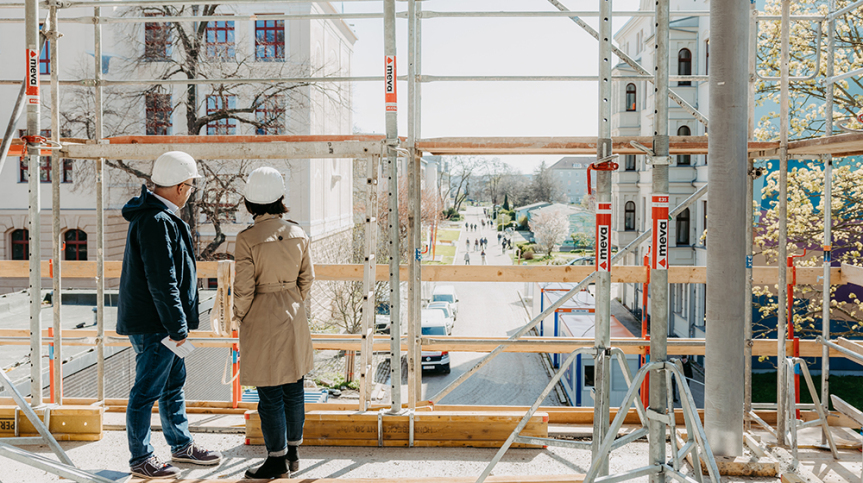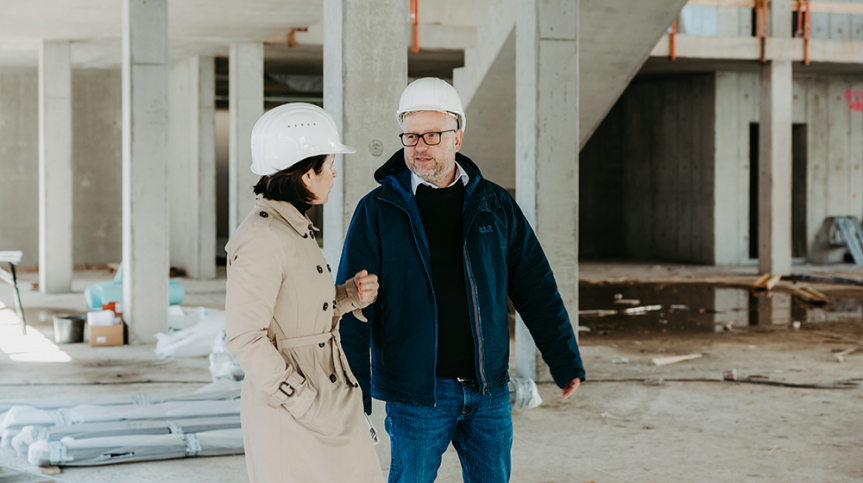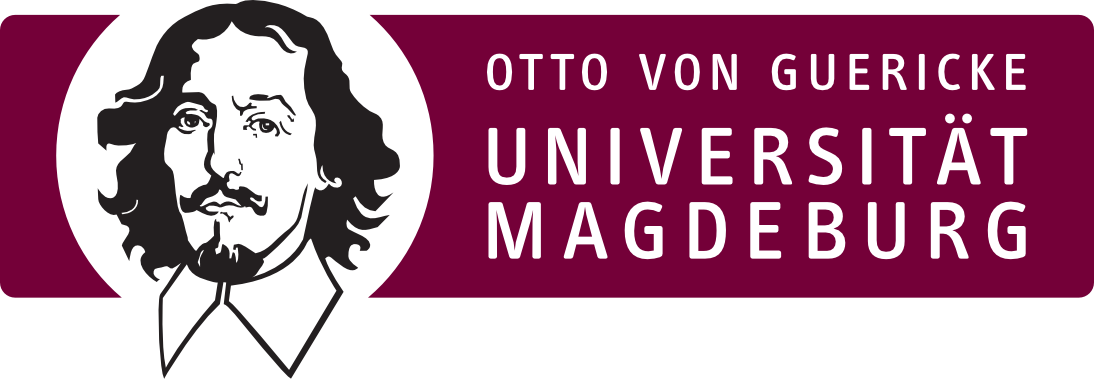
Sustainable, barrier-free, climate-neutral, family-friendly and digital; geared towards contemporary, equipment-intensive engineering research and modern, cross-space and cross-disciplinary teaching and with sufficient space for new work, co-work and cargo bikes; easy to reach by public transport in the city center, but with parking facilities for commuters: the demands on our aging campus are enormous. But are they realistic? What is necessary, what is possible and what can we still afford? Questions that university spokeswoman Katharina Vorwerk put to Clemens Klein, Head of Building, at an unusual location on campus.
Mr. Klein, for this interview we are standing on one of the largest construction sites on campus at the former Campus Service Center. What is happening here?
The Welcome Center will be a contact point where, for the first time, all services for students and visiting academics will be brought together under one roof on a usable area of 1,800 square meters. For this purpose, 7,000 tons of earth were removed by 280 truckloads, over 2,500 cubic meters of concrete were poured and 21 kilometers of power cables and 27 kilometers of data cables were laid. 88 radiators are supplied via almost 2 kilometers of piping.
The University of Magdeburg is 30 years old, and if you include its predecessor institutions, it's 70 years old. Many buildings probably need more than just cosmetic repairs?
Over 70 percent of our buildings are in at least good condition. The remaining 30 percent are on our agenda for structural alterations, depending on their importance. Employees in operational technology work tirelessly to use software to analyze our buildings over their entire life cycle and ensure a high level of operational safety for the technical systems.
Is the campus part of the city center?
It is a lively part of the city center and a self-sufficient part of a university educational institution with special needs. We have now recorded and analyzed all of the site's potential and deficits in their functional and spatial context for the first time. The result is a strategic master plan that will help us to develop a campus as an urban space with its own sustainable identity.
Urban planning regulations require a 13 percent reduction in motorized private transport in Magdeburg. What does this mean for the campus?
This means that a new, sustainable traffic concept must be developed for the university campus. In principle, we should think about traffic calming on the campus. This will create a higher quality of stay with short connections. In the long term, it would be conceivable to set up a central mobility hub with mobility management, charging facilities for electric vehicles and bicycle garages.
 Head of Building Clemens Klein and press spokeswoman Katharina Vorwerk in conversation at the Welcome Center construction site (Photo: Jana Dünnhaupt / University of Magdeburg)
Head of Building Clemens Klein and press spokeswoman Katharina Vorwerk in conversation at the Welcome Center construction site (Photo: Jana Dünnhaupt / University of Magdeburg)
We need both quality of stay and sustainable places for research and teaching. Too high a demand for the available resources?
Our campus at Uniplatz offers a good starting point for creating an open space as a calling card with exciting pathways, urban squares and natural green spaces. However, implementing the growing quality requirements for contemporary research and teaching is clearly a major challenge under the current conditions. A permanently usable, creative and attractive environment should be created for students. Those involved should have the future in mind, as the rooms or buildings should be usable for several decades in the long term.
The university library is also under construction, what will change for users?
The most important goal was that the roof was finally sealed after 20 years and that we could say goodbye to the misused waste paper baskets on the shelves. We installed photovoltaics in the new roof and are thus making a contribution to climate neutrality. Inside, we are creating a modern learning space with parent-child rooms, additional small group study rooms and the roof terrace is to be redesigned. The number of workstations will be significantly increased and reading islands and plenty of seating will be created. Last but not least, we are meeting the changed fire safety requirements and carrying out overdue work here.
What challenges are there in remodeling the university library?
The biggest challenge is to carry out the construction work while the library is open. We are only closing the library for the erection and dismantling of the interior scaffolding, which is essential for the roof renovation. The interior work will be carried out in parallel. The exciting thing here is to coordinate all the individual measures so that work is still possible, at least in parts.
Large parts of the campus have been torn up, is progress being made with the implementation of our energy concept?
The aim of the project is to provide a central supply of heating and cooling energy for the next few years. The Universitätsplatz campus has an annual energy requirement of 16 million kilowatt hours of electrical energy, 16.6 million kilowatt hours of thermal energy and 8.3 million kilowatt hours of cooling energy, as much as a medium-sized town. The biggest challenge in implementing the concept is the cooling supply, but in total there are four key areas.
Which ones are they?
Firstly, the central supply system ZVA. Due to a changed energy supply structure, new legal requirements and the university's climate targets, we need a new concept for the heating and cooling supply. The new ZVA will be built in front of the new vehicle fleet in the direction of Nordpark. The old garages will be demolished to create space for construction. From 2024, the campus will be supplied with 100 percent green electricity.
The second building block is the laying of the district heating and cooling lines. The university's cooling requirements have increased enormously over the past decade. At present, this cooling energy is still generated decentrally in the individual buildings. Once the cooling network has been completed, cooling will be generated centrally in order to better balance out peak loads.
The third area of the energy concept concerns the expansion of the existing fiber optic network due to the sharp increase in data traffic requirements. The lines will be laid together with the new heating and cooling lines.
Last but not least, photovoltaic systems were installed on buildings 18, 22, 23, 24 and 30 in 2023 and further systems will be implemented from 2024 - depending on the release of funds by the state. This will enable us to cover part of the electrical base load ourselves and make significant progress towards a climate-friendly campus.
 Head of Building Clemens Klein and press spokeswoman Katharina Vorwerk in conversation at the Welcome Center construction site (Photo: Jana Dünnhaupt / University of Magdeburg)
Head of Building Clemens Klein and press spokeswoman Katharina Vorwerk in conversation at the Welcome Center construction site (Photo: Jana Dünnhaupt / University of Magdeburg)
What specific consequences do the extensive construction measures have for university operations?
There will always be temporary restrictions at various points, but we will inform you about these in good time. The construction sites for the energy concept on campus in particular will lead to considerable restrictions due to the civil engineering work.
The infrastructure in the field of microtechnology, including the clean room, would have to be upgraded if training capacities were to be expanded. What ideas are there for this?
Renovating our cleanroom would lead to it being closed for at least two years and an abrupt interruption to the training and research that has just started in the cleanroom. The current location in the building of the Faculty of Electrical Engineering and Information Technology is also no longer up to date. If the cleanroom is needed even more extensively in the future, for example as a core facility, i.e. as an infrastructure used across institutions in the region, it will be necessary to think less about an expansion and more about a new location.
The university is also building outside the campus boundaries, for example in Barleben in the CMD, how are things progressing there?
The Center for Method Development - i.e. the CMD - in Barleben consists of the test benches for new drive research, the associated building equipment and office and social areas. Considering that the foundation stone was laid in July 2022, the construction time for 10 highly complex test benches and the technical facilities for operating the test benches was less than a year, which is incredibly fast! A new data center node for the state's universities is currently being planned, which is to be completed by 2025 as an important interface in the state's science network.
For years, the state has accused the university of using an inappropriate amount of space and thus causing additional costs. What is the status of this different assessment of what we need?
We are currently having the existing buildings assessed by an engineering firm in order to determine the costs of a necessary energy-efficient refurbishment and to draw up a refurbishment roadmap. There is considerable potential for saving energy costs through insulation measures on the facades, basement ceilings and by replacing windows. We are also planning to use storage technologies. All in all, we will therefore not incur such high costs with a modern building stock. At the same time, of course, all structural units are called upon to use the available space sparingly. In my opinion, there is still room for improvement in some areas.
How many millions of euros have been spent since the University of Magdeburg was founded?
From 1996 to 2022, around 160 million euros were invested in the university's building maintenance. Added to this are the numerous pilot building projects, such as
- 6 million euros for the library,
- 20 million for the Welcome Center,
- 37 million for the CMD,
- 12 million for our Energy Concept 2020 and
- 15 million euros for the 7 Tesla MRI.
The coronavirus ventilation system will cost 1.4 million euros, while the new data center at the CMD in Barleben will cost 8 million euros. The list also does not include the necessary energy-efficient refurbishment of the buildings. The sums involved here are considerable.
You are out and about on campus every day, do you have a favorite place?
Yes, it's the new meeting room here on the 3rd floor of the Welcome Center! From there, I have a wonderful view of the campus and can see the mix of architectural styles, construction periods, uses and height developments. With the future roofing at the campus entrance, a counterpart to the overhang of the university library has been created; according to the master plan, the connection will become the green, vehicle-free campus axis. Rethinking the campus in this way is an exciting and enjoyable task that I am looking forward to.
Mr. Klein, thank you very much for the interview!
